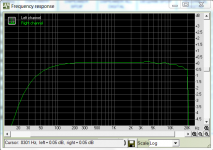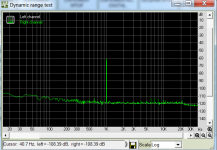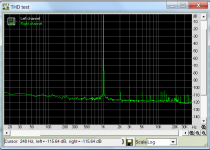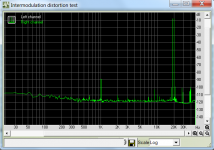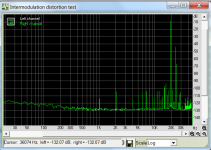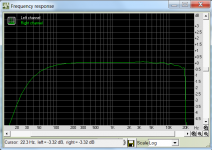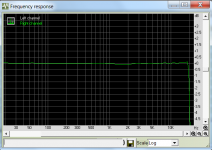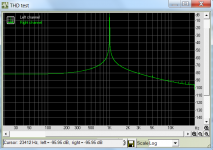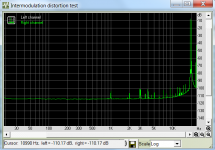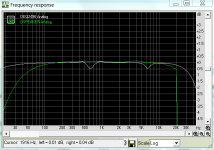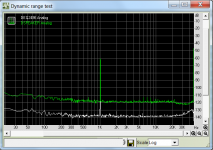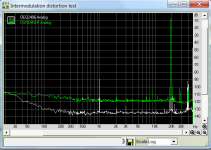This is PART 1 of my report (see other parts below).
I understand that this article may not be 100% fit for DIY Audio, but it is too technical for other forums like AVSForum, where I also a member. And I do compare commercial product with result of my DIY work. That is why I decided to publish my findings here.
Modern computing technology made significant progress in the last 15-20 years. It made cost of processing audio low enough, so it became common even in low cost devices. But most implementation are dedicated to multichannel audio for movies sound track, built into AVRs and surround processors. For some time there were efforts to expand digital audio processing to stereo systems designed to play music. But most hobbyists in hi-fi (or rather high-end) audio are very conservative in anything that is added to audio chain and violates rule “less is more” very popular among that crowd. But in recent years several vendors tried to convince owners of high quality music playing systems that they should add digital processing that compensates for speaker-room interaction and thus improve sound on top of passive room treatment. Thus we saw products from MiniDSP, DEQX and DSpeaker. I myself believed in having playback chain short (even as I do use and like Audyssey XT in my surround system ).
One of the main drawbacks of using signal processor is a fact that it has to be placed right before power amplifier and thus process analog rather than digital signal. As a result it adds additional A/D and D/A conversion, since all processing is done in digital domain. If music system uses only digital sources, this conversion can be avoided by placing digital processor before DAC (or using D/A convertor in it as DAC for the whole system). But with analog sources (vinyl media is still alive and kicking), this is not an option. As a result users have to trust that additional conversion stages do not alter sound to a degree when it can be heard. That is why ( despite actually working on device of that kind – see my report here http://www.diyaudio.com/forums/digital-line-level/282346-ultimate-behringer-mod-50-deq2496-1-a.html ) I didn’t try up to today any digital audio processing in my dedicated music system, using only passive room treatment to improve sound. But in my room I could go only so far.
And finally I decided to try one of digital processors which was for few years promoted in several magazines and web sites dedicated to high-end audio. Last trigger was a promotion letter that promised 40% discount on DSpeaker Anti-mode Dual Core. That device was called product of the year by Absolute Sound and received Class A recommendation from Stereophile (though neither published measurements confirming their rating). Considering offered discount, it was no brainer to place and order – I would not loose much if I do not like it and have to sell in near mint condition.
So I placed an order and soon box from California arrived at my door steps. My approach to anything new I get for audio is: put it on test bench before fist use. It allows me to avoid wasting my time on trying something that is broken (accidentally or by design). That was my approach to tube audio (you may find my reports about two tube amplifiers on that site http://www.diyaudio.com/forums/tubes-valves/208987-yaqin-mc-100b-powerful-advertised-value.html http://www.diyaudio.com/forums/tubes-valves/255409-lian-845-set-kit-commercial-product.html ) and I wanted to follow the same rule with my new digital processor – first confirm that it works as advertised. Thus this small black box went to my home lab for a proper testing.
Here are main parameters advertised by manufacturer:
[FONT=Arial, serif]
Interfaces:[/FONT]
• [FONT=Arial, serif]2 x RCA inputs or alternatively 2 x XLR inputs[/FONT]
• [FONT=Arial, serif]2 x RCA outputs and 2 x XLR outputs[/FONT]
• [FONT=Arial, serif]Toslink S/PDIF digital input (2-channel PCM only, maximum rate 96 kHz)[/FONT]
• [FONT=Arial, serif]Toslink S/PDIF digital output (48 kHz)[/FONT]
• [FONT=Arial, serif]USB Audio (USB used also for measurement export and software update)[/FONT]
[FONT=Arial, serif]Analog Specifications:[/FONT]
• [FONT=Arial, serif]Dynamic Range: > 108dB[/FONT]
• [FONT=Arial, serif]Total Harmonic Distortion (analog in, analog out, typical): 0.003%[/FONT]
I planned to use it between my preamplifier and power amplifier, both of which have balanced interfaces, that matched well to DSpeaker offering balanced analog connections. Thus limitation of digital inputs in it was not an issue (and I do play high-resolution PCM and DSD content using my DAC).
As you can see dynamic range and distortion numbers are good enough on paper for practical use even with high quality systems like mine (Accuphase pre- and Bryston power amplifiers, B&W 802D speakers). But if DSpeaker lives up to specs – that is what I was planning to find.
For measurements in that case I use computer with RMAA Pro ( RightMark Audio Analyzer. Products. Audio Rightmark ) software tool that does measure main audio quality parameters and allows easy side by side comparison. My venerable EMU 0404USB is the A/D and D/A interface used along with it. This is not the latest signal processor, but it is well known to have exceptionally low noise and distortion which allows reasonably accurate measurements of most modern audio gear.
Thus I built a test system where I used balanced cables between EMU and DSpeaker units. I also used Toslink cables for SPDIF interface measurements (DSpeaker only has optical input and output). I did measurements with my laptop running from battery, but I didn’t notice any difference from using external power. Before measurements, I did factory reset of DSpeaker to make sure that there were no leftover configuration settings that affected the performance. Volume control and input trim settings in DSpeaker were set to 0 dB. In all measurements other than pure digital I used EMU in 24 bit and 96kHz sampling mode. In digital only measurement I had to use 24 bit 48 kHz sampling (see explanation below).
First test was for high level frequency response. And here is what I saw: Fig 1 (see attachments below).
Oops… I easily came to three conclusions:
As you can see output signal is reaching exactly -60 dB, which means that DSpeaker has a unity gain. But (Oops.. again) the noise floor is at -120 dB at middle and raises to -110 dB at low frequencies. Overall measured dynamic range according to RightMark tool is 88 dB which is way below advertised 108 dB. Of cause we do not know what adjustment curve was used by manufacturer to specify the value. RighMark tool does not use any correction (A, C etc.) and noise level is calculated over full frequency range. A can imagine that magic 108 dB number can be achieved when using A weighting. But from what we see it is clear that DSpeaker offers at best 16 bits of resolution, exactly what CD gives us – say bye-bye any advantage from high-resolution digital sources. Modern DACs offer from 18 (entry level), to 19-20 (mainstream), to 21 (state of the art) bits of resolution. Again there is no excuse not to have at least 18 effective bits of dynamic range in any modern device. Considering that when used in pure analog mode DSpeaker should never see 0 dB signal at its input (otherwise ADC will clip) practical dynamic range is even lower by at least one bit. Thus dynamic range of DSpeaker is LOWER that recording on CD.
Now let’s see how much of harmonic distortions DSpeaker adds to the signal. For that I used full range 1 kHz input signal: Fig 3
Here we see that harmonics are quite low, with third is the highest at – 97 dB. All other are below -100 dB and thus are not really an issue. Though you can see a lot of high frequency hash, even beyond 20 kHz pass band limit. Overall THD is 0.0028%, which is within manufacturer’s specification. But you can see that overall noise level raises few dB up from -120 baseline, which may point to rounding errors in processing.
Now let’s look at IMD. For that two tones (19 kHz and 20 kHz) at -7 dB level were sent to DSpeaker input: Fig 4.
Result is not bad at all (if ignore already known issue with limited dynamic range). 1 kHz difference tone is just above -90 dB. Third order IMD components and aliases at 30 and 40 kHz are all below -100 dB. Overall it results in IMD at 0.013%. This is not exceptional, but not bad either.
As a summary of DSpeaker performance in analog chain, I can say that it can be used only if the music source is CD and owner of the system does not try to squeeze last drop of sound quality. But would people like this even bother with adding another device to their music system?
(Story continues below...)
I understand that this article may not be 100% fit for DIY Audio, but it is too technical for other forums like AVSForum, where I also a member. And I do compare commercial product with result of my DIY work. That is why I decided to publish my findings here.
Modern computing technology made significant progress in the last 15-20 years. It made cost of processing audio low enough, so it became common even in low cost devices. But most implementation are dedicated to multichannel audio for movies sound track, built into AVRs and surround processors. For some time there were efforts to expand digital audio processing to stereo systems designed to play music. But most hobbyists in hi-fi (or rather high-end) audio are very conservative in anything that is added to audio chain and violates rule “less is more” very popular among that crowd. But in recent years several vendors tried to convince owners of high quality music playing systems that they should add digital processing that compensates for speaker-room interaction and thus improve sound on top of passive room treatment. Thus we saw products from MiniDSP, DEQX and DSpeaker. I myself believed in having playback chain short (even as I do use and like Audyssey XT in my surround system ).
One of the main drawbacks of using signal processor is a fact that it has to be placed right before power amplifier and thus process analog rather than digital signal. As a result it adds additional A/D and D/A conversion, since all processing is done in digital domain. If music system uses only digital sources, this conversion can be avoided by placing digital processor before DAC (or using D/A convertor in it as DAC for the whole system). But with analog sources (vinyl media is still alive and kicking), this is not an option. As a result users have to trust that additional conversion stages do not alter sound to a degree when it can be heard. That is why ( despite actually working on device of that kind – see my report here http://www.diyaudio.com/forums/digital-line-level/282346-ultimate-behringer-mod-50-deq2496-1-a.html ) I didn’t try up to today any digital audio processing in my dedicated music system, using only passive room treatment to improve sound. But in my room I could go only so far.
And finally I decided to try one of digital processors which was for few years promoted in several magazines and web sites dedicated to high-end audio. Last trigger was a promotion letter that promised 40% discount on DSpeaker Anti-mode Dual Core. That device was called product of the year by Absolute Sound and received Class A recommendation from Stereophile (though neither published measurements confirming their rating). Considering offered discount, it was no brainer to place and order – I would not loose much if I do not like it and have to sell in near mint condition.
So I placed an order and soon box from California arrived at my door steps. My approach to anything new I get for audio is: put it on test bench before fist use. It allows me to avoid wasting my time on trying something that is broken (accidentally or by design). That was my approach to tube audio (you may find my reports about two tube amplifiers on that site http://www.diyaudio.com/forums/tubes-valves/208987-yaqin-mc-100b-powerful-advertised-value.html http://www.diyaudio.com/forums/tubes-valves/255409-lian-845-set-kit-commercial-product.html ) and I wanted to follow the same rule with my new digital processor – first confirm that it works as advertised. Thus this small black box went to my home lab for a proper testing.
Here are main parameters advertised by manufacturer:
[FONT=Arial, serif]
Interfaces:[/FONT]
• [FONT=Arial, serif]2 x RCA inputs or alternatively 2 x XLR inputs[/FONT]
• [FONT=Arial, serif]2 x RCA outputs and 2 x XLR outputs[/FONT]
• [FONT=Arial, serif]Toslink S/PDIF digital input (2-channel PCM only, maximum rate 96 kHz)[/FONT]
• [FONT=Arial, serif]Toslink S/PDIF digital output (48 kHz)[/FONT]
• [FONT=Arial, serif]USB Audio (USB used also for measurement export and software update)[/FONT]
[FONT=Arial, serif]Analog Specifications:[/FONT]
• [FONT=Arial, serif]Dynamic Range: > 108dB[/FONT]
• [FONT=Arial, serif]Total Harmonic Distortion (analog in, analog out, typical): 0.003%[/FONT]
I planned to use it between my preamplifier and power amplifier, both of which have balanced interfaces, that matched well to DSpeaker offering balanced analog connections. Thus limitation of digital inputs in it was not an issue (and I do play high-resolution PCM and DSD content using my DAC).
As you can see dynamic range and distortion numbers are good enough on paper for practical use even with high quality systems like mine (Accuphase pre- and Bryston power amplifiers, B&W 802D speakers). But if DSpeaker lives up to specs – that is what I was planning to find.
For measurements in that case I use computer with RMAA Pro ( RightMark Audio Analyzer. Products. Audio Rightmark ) software tool that does measure main audio quality parameters and allows easy side by side comparison. My venerable EMU 0404USB is the A/D and D/A interface used along with it. This is not the latest signal processor, but it is well known to have exceptionally low noise and distortion which allows reasonably accurate measurements of most modern audio gear.
Thus I built a test system where I used balanced cables between EMU and DSpeaker units. I also used Toslink cables for SPDIF interface measurements (DSpeaker only has optical input and output). I did measurements with my laptop running from battery, but I didn’t notice any difference from using external power. Before measurements, I did factory reset of DSpeaker to make sure that there were no leftover configuration settings that affected the performance. Volume control and input trim settings in DSpeaker were set to 0 dB. In all measurements other than pure digital I used EMU in 24 bit and 96kHz sampling mode. In digital only measurement I had to use 24 bit 48 kHz sampling (see explanation below).
First test was for high level frequency response. And here is what I saw: Fig 1 (see attachments below).
Oops… I easily came to three conclusions:
- Low frequencies response is limited by -3.5 dB loss at 20Hz. This hardly can be called transparent when makers of DSpeaker declare one of their device uses as subwoofer equalizer. What kind of subwoofer they are talking here – one that comes with tiny satellites as HT-In-The-Box?
- Response in top three octaves has visible ripple. This usually points to poor implementation of reconstruction filter when there is not enough processing power for that.
- High frequencies are limited to just above 20 kHz with sharp rolloff above that point. This simply means that this DSpeaker is useless in a system where high-resolution content is played (this actually includes vinyl – it has some content in low ultrasonic range, and people value it for that). This means that if someone uses DSpeaker he will not have value from high resolution music sources. This also causes phase and timing smear associated with low sampling rate. Based on my measurements I concluded that it is likely that input audio sampling and internal processing is done at 48 kHz rate. Considering that digital processing was routinely done at 96 kHz rate even a decade ago, there is little excuse not to have it in device targeting high quality audio market.
As you can see output signal is reaching exactly -60 dB, which means that DSpeaker has a unity gain. But (Oops.. again) the noise floor is at -120 dB at middle and raises to -110 dB at low frequencies. Overall measured dynamic range according to RightMark tool is 88 dB which is way below advertised 108 dB. Of cause we do not know what adjustment curve was used by manufacturer to specify the value. RighMark tool does not use any correction (A, C etc.) and noise level is calculated over full frequency range. A can imagine that magic 108 dB number can be achieved when using A weighting. But from what we see it is clear that DSpeaker offers at best 16 bits of resolution, exactly what CD gives us – say bye-bye any advantage from high-resolution digital sources. Modern DACs offer from 18 (entry level), to 19-20 (mainstream), to 21 (state of the art) bits of resolution. Again there is no excuse not to have at least 18 effective bits of dynamic range in any modern device. Considering that when used in pure analog mode DSpeaker should never see 0 dB signal at its input (otherwise ADC will clip) practical dynamic range is even lower by at least one bit. Thus dynamic range of DSpeaker is LOWER that recording on CD.
Now let’s see how much of harmonic distortions DSpeaker adds to the signal. For that I used full range 1 kHz input signal: Fig 3
Here we see that harmonics are quite low, with third is the highest at – 97 dB. All other are below -100 dB and thus are not really an issue. Though you can see a lot of high frequency hash, even beyond 20 kHz pass band limit. Overall THD is 0.0028%, which is within manufacturer’s specification. But you can see that overall noise level raises few dB up from -120 baseline, which may point to rounding errors in processing.
Now let’s look at IMD. For that two tones (19 kHz and 20 kHz) at -7 dB level were sent to DSpeaker input: Fig 4.
Result is not bad at all (if ignore already known issue with limited dynamic range). 1 kHz difference tone is just above -90 dB. Third order IMD components and aliases at 30 and 40 kHz are all below -100 dB. Overall it results in IMD at 0.013%. This is not exceptional, but not bad either.
As a summary of DSpeaker performance in analog chain, I can say that it can be used only if the music source is CD and owner of the system does not try to squeeze last drop of sound quality. But would people like this even bother with adding another device to their music system?
(Story continues below...)
Attachments
This is PART 2 of my report
But maybe I can use DSpeaker also as DAC (one of use cases promoted by maker) with its digital input? USB interface is known to be limited to 24/48 format, but optical SPDIF interface is advertised to support input up to 24/96. That is why I decided to test DSpeaker performance in that application: digital input - analog output. Digital signal was produced by EMU interface though short optical cable.
First I again tested frequency response: Fig 5
Here we again see early rolloff at low frequencies, ripple through last three octaves (though it looks a bit different), and ( surprise! ) same steep roll of at 20 kHz. Thus despite supporting 96 kHz sampling rate through SPDIF, DSpeaker is still limited to low sampling rate internally. I suspect that it simply converts whatever incoming data it receives into internal fixed sampling rate of 48 kHz. Thus users cannot get any advantage of high resolution source material, even when DSpeaker does not need to do A/D conversion.
Now dynamic range test, just like I did for analog input, but now signal is sent to DSpeaker via SPDIF: Fig 6
We can see that noise floor dropped about 10 dB down to – 130 dB. It means that when digital input is used, DSpeaker offers up to 2 more effective bits of resolution (and low dynamic range in analog mode was due to limitation of ADC). But it does not help when so much of high frequency hash is now seen added to the output. From my experience this is usually the result of poor jitter reduction (this is most likely the root cause, since we do not see anything like that with analog input, when DSpeaker only uses its own clock source). Optical SPDIF interfaces never were exemplary in low jitter and thus any receiving device should have very robust clock recovery circuit (or use ASRC). It seems DSpeaker has neither. Below result of IMD tests confirm that: Fig 7
Intermodulation tone at 1kHz is very low, but we see a lot of components from 2 kHz and up, which correlates with high jitter. Also you can notice that alias components at around 25 kHz are not fully suppressed. I do not now really understand why alias suppression is so different in analog vs. digital input. The only explanation could be that designers used different reconstruction filters in these modes.
From the results above you can see that DSpeaker is not very good when used in digital input mode (actually mostly promoted by its makers) – it does add about two bits of resolution (and expands dynamic range), but still limits sampling rate internally at 48 kHz and now adds a lot of jitter related artefacts to the output signal.
(Story continues below...)
But maybe I can use DSpeaker also as DAC (one of use cases promoted by maker) with its digital input? USB interface is known to be limited to 24/48 format, but optical SPDIF interface is advertised to support input up to 24/96. That is why I decided to test DSpeaker performance in that application: digital input - analog output. Digital signal was produced by EMU interface though short optical cable.
First I again tested frequency response: Fig 5
Here we again see early rolloff at low frequencies, ripple through last three octaves (though it looks a bit different), and ( surprise! ) same steep roll of at 20 kHz. Thus despite supporting 96 kHz sampling rate through SPDIF, DSpeaker is still limited to low sampling rate internally. I suspect that it simply converts whatever incoming data it receives into internal fixed sampling rate of 48 kHz. Thus users cannot get any advantage of high resolution source material, even when DSpeaker does not need to do A/D conversion.
Now dynamic range test, just like I did for analog input, but now signal is sent to DSpeaker via SPDIF: Fig 6
We can see that noise floor dropped about 10 dB down to – 130 dB. It means that when digital input is used, DSpeaker offers up to 2 more effective bits of resolution (and low dynamic range in analog mode was due to limitation of ADC). But it does not help when so much of high frequency hash is now seen added to the output. From my experience this is usually the result of poor jitter reduction (this is most likely the root cause, since we do not see anything like that with analog input, when DSpeaker only uses its own clock source). Optical SPDIF interfaces never were exemplary in low jitter and thus any receiving device should have very robust clock recovery circuit (or use ASRC). It seems DSpeaker has neither. Below result of IMD tests confirm that: Fig 7
Intermodulation tone at 1kHz is very low, but we see a lot of components from 2 kHz and up, which correlates with high jitter. Also you can notice that alias components at around 25 kHz are not fully suppressed. I do not now really understand why alias suppression is so different in analog vs. digital input. The only explanation could be that designers used different reconstruction filters in these modes.
From the results above you can see that DSpeaker is not very good when used in digital input mode (actually mostly promoted by its makers) – it does add about two bits of resolution (and expands dynamic range), but still limits sampling rate internally at 48 kHz and now adds a lot of jitter related artefacts to the output signal.
(Story continues below...)
Attachments
This is thrird and final part of my report
Finally I tried to see if use full digital mode is any better. For that test I had to limit sampling rate of my EMU unit to 48 kHz. EMU cannot work with different sampling frequencies in input and output. But DSpeaker always sets its SPDIF output to 48 kHz, regarding of what input signal it receives (this is probably the proof that all processing is done on fixed sample rate of 48 kHz).
Again I started with frequency response: Fig 8
Finally we can see that there is no low frequency rolloff, which is likely was caused by DAC circuit. But we still see ripple at high octaves. I wonder why – there is no need to filtering anywhere (I made sure that no real processing is configured in device) and it should behave like digital wire, but apparently something is still happening inside DSpeaker.
Next test is full range 1 kHz tone. And now we see much bigger Oops.. Fig 9
Looks like a lot of clipping happens somewhere. Apparently DSpeaker cannot tolerate full scale digital input signal when running in fully digital mode. And IMD test just confirms that: Fig 10
Noise floor is much higher than it should be (if we assume 18 bits processing), which again points to digital clipping (or rounding).
As you can see – DSpeaker is completely useless in pure digital mode, as it cannot tolerate full dynamic range without overflow in internal processing.
And to give you a perspective, I compared DSpeaker with slightly modified Berhinger DEQ2494 equalizer (street price below $250 with less than $50 worth of components replaced – see my article referenced above). I set two filters in DEQ2496 parametric stage to make sure it does actual processing, and you see them in frequency response curve: Fig 11 - 13
As you can see DEQ2496, while not pretending for place in high-end audio installations, offers almost 3 more bits of resolution and thus 15-18 dB better dynamic range (it does indeed achieve 108 dB value). It also natively processes sound signal at sampling rates up to 96 kHz, and does not experience low or high frequency roll offs. Now you probably know what I will try first in my music system. But this is the topic for following report.
As to DSpeaker, it went back into the box it arrived in, while getting ready to be sold. When I get my funds back, I will try my luck with MiniDSP running Dirac Live. Being priced at the same level (though not offered with steep discount), it is a direct competitor. Hopefully its makers did a better job.
I welcome comments to my findings.
Finally I tried to see if use full digital mode is any better. For that test I had to limit sampling rate of my EMU unit to 48 kHz. EMU cannot work with different sampling frequencies in input and output. But DSpeaker always sets its SPDIF output to 48 kHz, regarding of what input signal it receives (this is probably the proof that all processing is done on fixed sample rate of 48 kHz).
Again I started with frequency response: Fig 8
Finally we can see that there is no low frequency rolloff, which is likely was caused by DAC circuit. But we still see ripple at high octaves. I wonder why – there is no need to filtering anywhere (I made sure that no real processing is configured in device) and it should behave like digital wire, but apparently something is still happening inside DSpeaker.
Next test is full range 1 kHz tone. And now we see much bigger Oops.. Fig 9
Looks like a lot of clipping happens somewhere. Apparently DSpeaker cannot tolerate full scale digital input signal when running in fully digital mode. And IMD test just confirms that: Fig 10
Noise floor is much higher than it should be (if we assume 18 bits processing), which again points to digital clipping (or rounding).
As you can see – DSpeaker is completely useless in pure digital mode, as it cannot tolerate full dynamic range without overflow in internal processing.
And to give you a perspective, I compared DSpeaker with slightly modified Berhinger DEQ2494 equalizer (street price below $250 with less than $50 worth of components replaced – see my article referenced above). I set two filters in DEQ2496 parametric stage to make sure it does actual processing, and you see them in frequency response curve: Fig 11 - 13
As you can see DEQ2496, while not pretending for place in high-end audio installations, offers almost 3 more bits of resolution and thus 15-18 dB better dynamic range (it does indeed achieve 108 dB value). It also natively processes sound signal at sampling rates up to 96 kHz, and does not experience low or high frequency roll offs. Now you probably know what I will try first in my music system. But this is the topic for following report.
As to DSpeaker, it went back into the box it arrived in, while getting ready to be sold. When I get my funds back, I will try my luck with MiniDSP running Dirac Live. Being priced at the same level (though not offered with steep discount), it is a direct competitor. Hopefully its makers did a better job.
I welcome comments to my findings.
Attachments
Any chance you could test a KRK Ergo?
It is not as simple. Requires either a FireWire or Thunderbolt port on your computer. Also it upsamples everything to 96/24 for processing the DRC. It is not defeatable.
It is two or four channel. The other two are sub outs. Will perform DRC on analog too.
Fantastic functionality. I have one I could send to be tested.
It is not as simple. Requires either a FireWire or Thunderbolt port on your computer. Also it upsamples everything to 96/24 for processing the DRC. It is not defeatable.
It is two or four channel. The other two are sub outs. Will perform DRC on analog too.
Fantastic functionality. I have one I could send to be tested.
It is not as simple. Requires either a FireWire or Thunderbolt port on your computer. Also it upsamples everything to 96/24 for processing the DRC. It is not defeatable.
It is two or four channel. The other two are sub outs. Will perform DRC on analog too.
Fantastic functionality. I have one I could send to be tested.
Actually DRC is not bad thing at all. In my main DAC (Teac UD-501) I purposely enabled DRC. Its interpolation filter uses minimum phase algorithm that eliminates pre-ringing for CD quality source. It also completely gets rid of jitter. Teac does not have jitter issues when used with USB input, but does not behave good enough with SPDIF input. I my setup I use SPDIF (optical) as input from CD/SACD transport (Oppo DV-980H), with high-res content extracted from HDMI using audio de-embedder. That digital stream has very serious clock jitter - even worse than you can see in DSpeaker above. DRC completely eliminates all jitter artefacts.
DRM = Digital Room Correction
The DRM built into the Ergo is a version of Lyngdorf’s Room Perfect. Includes a calibrated mic to perform the measurements. It can be turned off. The upsampling to 96/24 cannot.
I upsample to 96/24 with Pure Music. The software upsampler is better than the hardware upsampler in the Ergo.
Actually DRC is not bad thing at all. In my main DAC (Teac UD-501) I purposely enabled DRC. Its interpolation filter uses minimum phase algorithm that eliminates pre-ringing for CD quality source. It also completely gets rid of jitter. Teac does not have jitter issues when used with USB input, but does not behave good enough with SPDIF input. I my setup I use SPDIF (optical) as input from CD/SACD transport (Oppo DV-980H), with high-res content extracted from HDMI using audio de-embedder. That digital stream has very serious clock jitter - even worse than you can see in DSpeaker above. DRC completely eliminates all jitter artefacts.
The DRM built into the Ergo is a version of Lyngdorf’s Room Perfect. Includes a calibrated mic to perform the measurements. It can be turned off. The upsampling to 96/24 cannot.
I upsample to 96/24 with Pure Music. The software upsampler is better than the hardware upsampler in the Ergo.
The DRM built into the Ergo is a version of Lyngdorf’s Room Perfect. Includes a calibrated mic to perform the measurements. It can be turned off. The upsampling to 96/24 cannot.
I upsample to 96/24 with Pure Music. The software upsampler is better than the hardware upsampler in the Ergo.
In my setup I try to use processor in analog chain between pre- and power amplifiers. Thus it has first to be as transparent as possible in A/D/A conversion steps. In my next tests (before I get MiniDSP with Dirac) I use modified DEQ2496. I will likely write full report, but now I can say that it is almost transparent. As for DRC, I use REW software and filters it suggests with a bit of manual adjustment.
Hi!
I found these thread today, so sorry in advance for my questions so many years after
I use my DSPeaker with USB in from my pc with roon core and rca out .If I understand this correct, Avp1, you don't recommend digital I/O. In the 2. part you said, that there is up to 2 more effective bits of resolution with SPDIF in. Is this the same with USB? Is the jitter equal to SPDIF? I try to find the best connection available for the AM Dual Core. THX in advance.
I found these thread today, so sorry in advance for my questions so many years after
I use my DSPeaker with USB in from my pc with roon core and rca out .If I understand this correct, Avp1, you don't recommend digital I/O. In the 2. part you said, that there is up to 2 more effective bits of resolution with SPDIF in. Is this the same with USB? Is the jitter equal to SPDIF? I try to find the best connection available for the AM Dual Core. THX in advance.
- Status
- This old topic is closed. If you want to reopen this topic, contact a moderator using the "Report Post" button.
- Home
- Source & Line
- Digital Source
- DSpeaker Dual Core 2.0 – Test Bench Report
